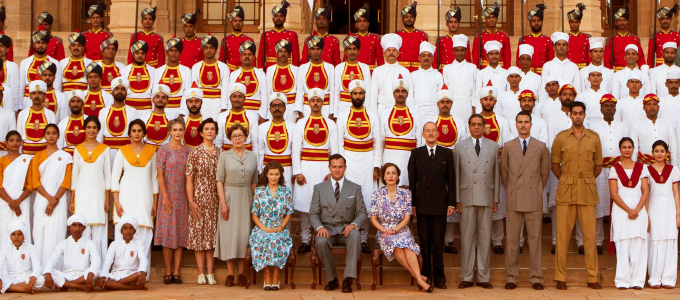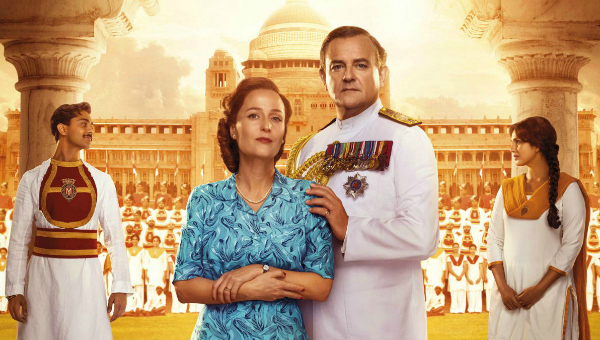 In the wrong hands, this lavishly told story of Indian independence in 1947 could have been little more than a gruesome transposition to the sub-continent of DOWNTON ABBEY, with a dash of MARIGOLD HOTEL cuteness thrown in for flavouring. That it (largely) isn’t – despite the presence of non-lookalike Hugh Bonneville as Lord Louis “Dickie” Mountbatten, the last Viceroy and charged with overseeing independence – is due to the commitment of the director and co-writer Gurinder Chadha, whose personal connection with the partition of India and Pakistan is revealed in a poignant end-credit.
In the wrong hands, this lavishly told story of Indian independence in 1947 could have been little more than a gruesome transposition to the sub-continent of DOWNTON ABBEY, with a dash of MARIGOLD HOTEL cuteness thrown in for flavouring. That it (largely) isn’t – despite the presence of non-lookalike Hugh Bonneville as Lord Louis “Dickie” Mountbatten, the last Viceroy and charged with overseeing independence – is due to the commitment of the director and co-writer Gurinder Chadha, whose personal connection with the partition of India and Pakistan is revealed in a poignant end-credit.
Nevertheless, the warning “Contains Brief Distressing Scenes” in the BBFC certificate at the start sums up the film’s somewhat perfunctory approach to the widespread bloodshed and misery occasioned by the displacement of millions of Hindus, Sikhs and Muslims forced to leave their homes and choose between the old country and the emerging one. With plentiful use of Movietone News footage, VICEROY’S HOUSE also adopts the same approach as JACKIE, recreating the seismic events of the time but mainly keeping them in the background as they unfold, while bringing the human drama to the fore.
As the Mountbattens arrive in Delhi to take up residence in their new home (the “house” having the same stature as “Buck House”, i.e. a palace) hundreds of servants scurry to make the place ready: polishing the row of pictures of previous Viceroys, dusting the large bust of Queen Victoria and punctiliously hoovering the miles of carpet. Among the staff are the young Hindu Jeet (Manish Dayal) assigned to dress Mountbatten in his many medals from previous campaigns in the navy and Burma, and the Muslim Aalia (Huma Qureshi) who works at the House while attending to her blind and ailing father (Om Puri) back in the village where she and Jeet have grown up.
“Pandit Pantsdown”
It’s soon apparent that their romance will serve a dual purpose: sugaring the pill of all the political manoeuvring, as Mountbatten struggles to find agreement between the country’s leaders (Pandit Jawaharlal Nehru, Muhammad Ali Jinnah and Mahatma Gandhi) and providing a metaphor for the forced separation of the religions, Aalia being torn between Jeet and her Muslim fiance.
As with the historical exposition at the start of the film between Mountbatten and his wife Edwina (Gillian Anderson) Jeet and Aalia’s dialogue is often clunking (“I’m not that girl any more”) and there’s no room here for the potentially much more interesting romance: the saintly and courtly Edwina’s rumoured affair with Nehru, India’s future Prime Minister. Their mutual attraction, seated chastely next to each other on equally elegant furniture, merits nothing more than a suspicious glance from Mountbatten’s chief of staff General Ismay (Michael Gambon) – so sadly the nickname “Pandit Pantsdown” still awaits a home.
The metaphor which does work is the dividing up in amusing detail of the Viceroy’s House itself as the 14th August deadline for Partition imposed on the hapless civil servant Sir Cyril Radcliffe (Simon Callow) approaches. The cutlery, books and musical instruments signifying the civilized lifestyle of the outgoing British rulers are designated for either India or Pakistan (apart from the bust of Victoria, carted back to the UK).
But outside in the House’s grounds, amid the milling thousands of starving refugees a feelgood climax is being engineered, the young lovers clinging to each other like Jack and Rose at the end of TITANIC while A.R. Rahman’s score (channeling James Horner’s) swirls round them – and the film unfortunately sinks with them.
httpvh://youtu.be/id_ZyNdvXKQ

